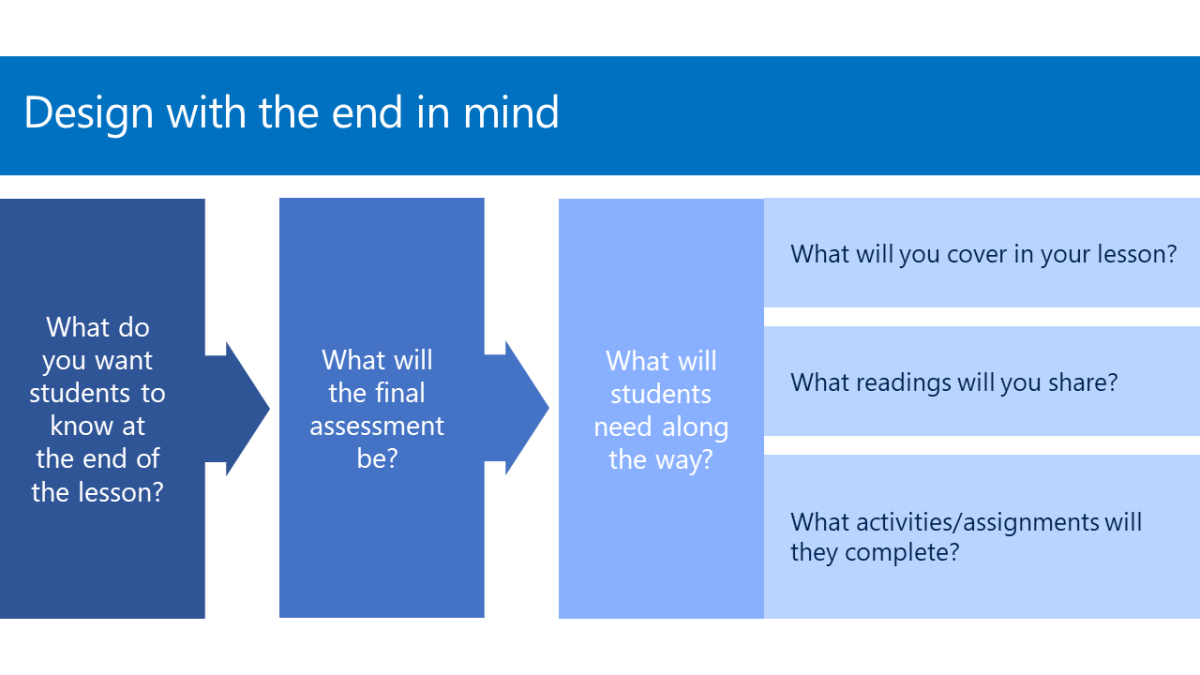Lesson design
When transitioning to a hybrid learning environment, instructors must evaluate their content and curricula to determine what is most essential for students to learn. Many educational institutions have found that "less is more" when looking at what content needs to be delivered synchronously and how it needs to be delivered (Resilience and transformation for the future of learning 7). When streamlining the focus of their course, instructors can simplify by considering the enduring understandings students need to have at the end of the course. Once instructors establish the enduring understandings, they can use Backward Design principles to plan their course and lessons with the end in mind. Once educators have their final destination in mind, they can create the final assessment for the unit that will measure if the students successfully reached the learning goals. Instructors can then think critically about what students need along the way to reach the end goal. What will need to be covered in each lesson? What readings/videos will need to be shared? What practice activities, assignments, and discussions will students need to complete? The Backward Design process creates a richer learning experience for students and guarantees that every activity, lesson, and discussion instructors plan supports the enduring understandings.

Another lesson design approach that can benefit hybrid learning models is Universal Design for Learning (UDL). The UDL framework guides instructors on the design of instructional goals, assessments, methods, and materials that can be personalized to meet individual students’ needs. When using the UDL framework, educators consider three UDL principles to design their course so that they provide multiple means of:
- Representation
- Action and expression
- Engagement
Once the course objectives are identified and the learning activities are created, instructors need to focus on strategies for delivering the content and communicating the learning plan and expectations to the students. When delivering content synchronously, brain research indicates that instructors must do something emotionally relevant every ten minutes in order to keep students’ attention (Medina 89-90). To create segmented lessons in a live lesson, instructors can pause at designated times and ask students to:
Share their thoughts, ask questions, answer questions
Complete a quick Forms poll or practice Forms quiz
Process or practice a concept
Discuss what they are learning with a partner
Use a simple emoji in the chat window to demonstrate their comfort level with the material
For asynchronous learning, instructors can record mini-lessons. Research reports that the optimal length of instructional videos is six minutes (Darby 53). If an instructional video is longer than six minutes, instructors should upload the video to Microsoft Stream and insert questions via Forms at specific points in the video that will allow students to pause and reflect on what they are learning before they move on and watch more.
Additionally, instructors should frequently communicate the learning goals, the learning plan, and expectations. A review of best practices in distance education found:
"Because distance education involves physical separation of teacher and student, the design of instruction must be highly precise to make sure that students have all of the information they need and that it is presented in a logical and easy-to-follow format."
(Nsiah 3-4). Therefore, instructors need to use a variety of methods to help students see the purpose of what they are learning. Instructors can provide written instructions, video or audio announcements, and daily and/or weekly reminders about what the learning goals are. Within the multi-modal communications, instructors must reinforce the core objectives repeatedly. Moreover, to improve retention, educators will want to continually reinforce concepts by connecting what students learned yesterday to what they are learning today.
Finally, to help students with structure and time management, instructors should plan to scaffold lessons and assignments. Providing students with smaller activities where they can practice skills and find success is one positive way to help prepare students for larger tasks that will be required in summative assessments.